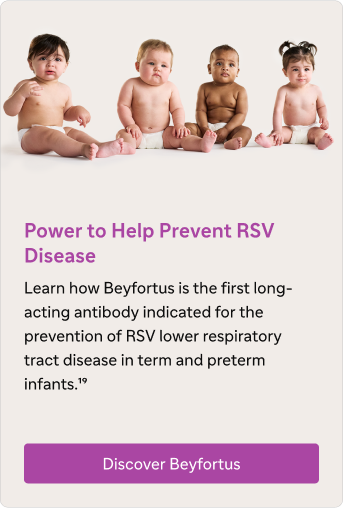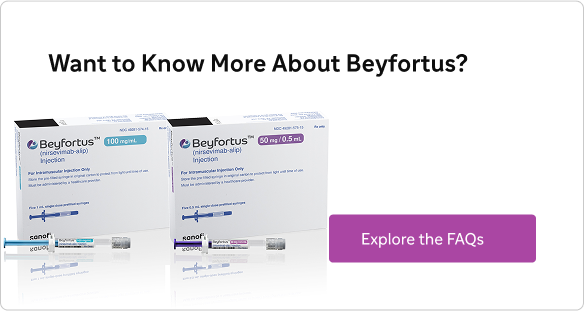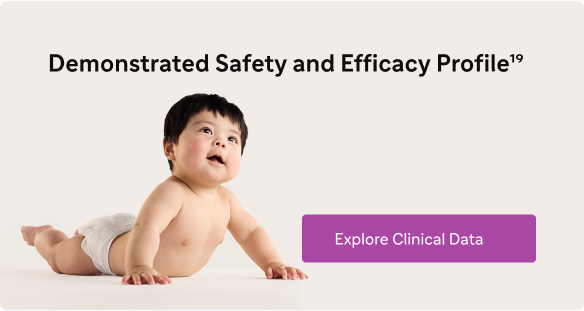Hospitalization, seasonality, and pathophysiology

Respiratory syncytial virus (RSV) poses a significant threat to infants in the United States; all infants are susceptible to developing lower respiratory tract infections caused by this virus. Although most of the time RSV will cause mild cold-like symptoms, we cannot predict which infants will develop RSV lower respiratory tract disease.1,2
RSV infections are particularly concerning due to their potential to cause severe respiratory illness and high hospitalization rates.3
Despite this universal risk, there remains a critical need for increased awareness of the burden of RSV on infants, as well as their parents and caregivers. We cannot predict which infants will develop RSV lower respiratory tract disease; therefore, proactive preventative measures such as infection control, monoclonal antibody prophylaxis, and caregiver education are essential.4
Recognizing RSV and its characteristics
RSV is a common and highly contagious respiratory virus that can lead to lower respiratory tract infections, and serious lung conditions such as pneumonia and bronchiolitis in neonates and infants. The pathogen belongs to the Pneumoviridae (genus orthopneumovirus), a family of negative-strand RNA viruses.2,4,5
Transmission occurs through the nasopharyngeal or conjunctival mucosa with respiratory secretions from infected individuals (ie. other children, older siblings/family members).6
RSV shares similar characteristics to that of other respiratory viruses, including7,8:
- Runny nose
- Congestion
- Decrease in appetite
- Coughing
- Sneezing
- Fever
- Wheezing
However, in very young infants, symptoms may include irritability, decreased activity, and breathing difficulties. RSV, therefore, remains an unpredictable threat.2,7
RSV incidence and hospitalization rates in infants
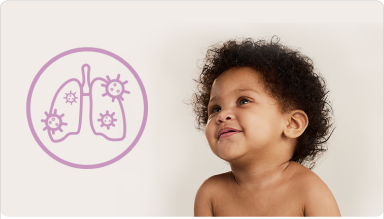
RSV is a prominent contributor to acute respiratory tract infections among young children.3,4
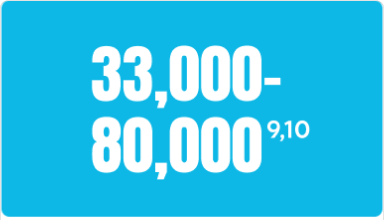
A recent meta-analysis found that US infants under 1 year old had an annual hospitalization rate of 19.4 per 1,000 due to RSV.
Extrapolating this to the 2020 US birth cohort suggests that around 80,000 RSV-associated infant hospitalizations may occur annually, aligning with CDC data.2,10*
*An analysis published in 2022 including studies between 2000-2020. Annual hospitalization rates ranged from 8.4 to 40.8 per 1,000, with a pooled rate of 19.4.10
The virus is also a significant contributor to pneumonia admissions, accounting for up to 50% of cases among infants.11
2 out of 3 infants will be infected with RSV by age 1.12
Infants younger than 1 year are, on average, 16x more likely to be hospitalized due to RSV than for influenza.13
Young infants under 6 months face an elevated risk of severe RSV, especially if born prematurely or with underlying conditions. Examples of such conditions include: chronic lung or congenital heart disease, and neurological issues or immunodeficiency.14
However, pre-existing risk factors are recognized in only 22-32% of total hospital admissions.4
.
As mentioned above, infants under 1 year of age are much more likely to be hospitalized due to RSV than influenza. However, for children aged 5 and older, influenza is more likely to lead to hospitalizations than RSV, highlighting the significant impact each virus has across different stages of life.13
These statistics on RSV hospitalization rates and incidence emphasize that RSV presents a risk to all infants, not just those born prematurely or with underlying medical conditions.13
.
RSV is the primary cause of hospitalization in infants. It leads to hospitalizations by causing bronchiolitis and pneumonia. Acute bronchiolitis due to RSV accounted for ~10% of total infant hospitalizations.15
Bronchiolitis manifests with14:
- Respiratory distress
- Coughing
- Differing levels of hypoxia caused by airway blockage in older children, and may present as apnea in infants
.
RSV seasonality
RSV is seasonal, with infections peaking at certain times throughout the year. A typical RSV season runs roughly from fall through spring, with some exceptions, such as in Florida and Hawaii, where the RSV season may start earlier.16-19
Shortly after the COVID-19 pandemic, the detection of RSV infections became more unpredictable in some regions, with many off-season resurgences of cases. Epidemiology monitoring can identify when local RSV seasons begin, and this will remain an important process as RSV seasonality shifts back to normal.14,20
Based on a 2019 UK study of the number of hospitalized infants born in-season (Oct-Mar: 48%) and born before the season (Apr-Sept: 50%), infants born before the RSV season are equally at risk as those born during it. As a result, the number of RSV-hospitalized infants born in-season vs before the season is roughly equal.21
RSV pathophysiology
See how RSV symptoms progress
RSV symptoms can progress from an asymptomatic stage to severe. Below is a timeline of the typical RSV symptoms over the duration of the disease*:
RSV at days 1 and 2
Droplets containing RSV from infected contact enter the infant's nasopharynx. There is usually no manifestation of symptoms at this point.22
RSV at days 3 through 5
Nasopharyngeal cells are sloughed off and may be aspirated, carrying RSV to lower respiratory tract cells.22
Symptoms can include:
- Congestion
- Runny nose
- Fever
- Irritability
- Poor feeding
RSV at days 6 through 8
RSV-infected epithelial cells can travel deeper into the infant's lungs, infecting the bronchioles and alveoli, causing bronchiolitis and/or pneumonia.6
Symptoms can include22:
- Cough
- Excess phlegm
- Rapid breathing (tachypnea)
- Wheezing and/or grunting noises
- Nasal flaring
- Abnormal chest movement when breathing
*This is one example of progression, which can vary in each individual infant.
RSV oxygen (O₂) therapy in cases of severe RSV
2 to 3 out of every 100 infants with RSV infection may need to be hospitalized; those hospitalized may require O₂, IV fluids, intubation, and/or mechanical ventilation.2
O₂ therapy in cases of severe RSV requires O₂ levels given at a higher rate through a nasal cannula, known as ‘high flow.’23
Respiratory rate as an indicator of RSV severity
Parents should be informed that respiratory rate is a key indicator when deciding to seek medical attention.
A respiratory ≥60 breaths/min for those under 2 months old, a respiratory ≥50 breaths/min for those 2 to 11 months old, and ≥40 breaths/min for those between 1 and 5 years old could indicate lower respiratory complications.24
Take a deeper dive into RSV
Quality of life burden on United States infants and caregivers due to lower respiratory tract infection and adjusting for selective testing
A pilot prospective observational study estimating the quality of life (QoL) for otherwise healthy, term US infants with RSV-LRTI and their caregivers.
Infants admitted to US intensive care units for RSV infection during the 2022 seasonal peak
A surveillance study of 600 infants across 39 hospitals requiring intensive care for RSV infection found that most were delivered full term and previously healthy.
Optimal site of care for administration of extended half-life RSV antibodies to infants in the United States (US)
A study to assess the time from birth hospitalization discharge to the first outpatient visit among US infants in order to determine the optimal site of administration for the extended half-life antibody.
Discover more about Beyfortus
Product images are representative of scale—actual size of packaging may be different.
CDC, Centers for Disease Control and Prevention; HCP, healthcare professional; IV, intravenous; LRTI, lower respiratory tract infection; RNA, ribonucleic acid; RSV, respiratory syncytial virus.
Important Safety Information
References: 1. Arriola CS, Kim L, Langley G, et al. Estimated burden of community-onset respiratory syncytial virus-associated hospitalizations among children aged <2 years in the United States, 2014-15. J Pediatr Infect Dis Soc. 2020;9(5):587-595. 2. RSV in infants and young children. Centers for Disease Control and Prevention. August 30, 2024. Accessed June 3, 2025. https://www.cdc.gov/rsv/infants-young-children/index.html 3. Reichert H, Suh M, Jiang X, et al. Mortality associated with respiratory syncytial virus, bronchiolitis, and influenza among infants in the United States: a birth cohort study from 1999 to 2018. J Infect Dis. 2022;226(suppl 2):S246-S254. 4. Baraldi E, Lisi GC, Costantino C, et al. RSV disease in infants and young children: can we see a brighter future? Hum Vaccine Immunother. 2022;18(4):2079322. 5. Yamin D, Jones FK, DeVincenzo JP, et al. Vaccination strategies against respiratory syncytial virus. Proc Natl Acad Sci USA. 2016;113(46):13239-13244. 6. Piedimonte G, Perez MK. Respiratory syncytial virus infection and bronchiolitis. Pediatr Rev. 2014;35(12):519-530. 7. Symptoms and care of RSV. Centers for Disease Control and Prevention. July 08, 2025. Accessed July 23, 2025. https://www.cdc.gov/rsv/symptoms/index.html 8. How to tell the difference between flu, RSV, COVID-19, and the common cold. National Foundation for Infectious Diseases. Accessed May 30, 2025. https://www.nfid.org/resource/how-to-tell-the-difference-between-flu-rsv-covid-19-and-the-common-cold/ 9. Rainisch G, Adhikari B, Meltzer MI, et al. Estimating the impact of multiple immunization products on medically-attended respiratory syncytial virus (RSV) infections in infants. Vaccine. 2020;38(2):251-257. 10. McLaughlin JM, Khan F, Schmitt H-J, et al. Respiratory syncytial virus-associated hospitalization rates among US infants: a systematic review and meta-analysis. J Infect Dis. 2022;225(6):1100-1111. 11. Walsh EE, Hall CB. Respiratory syncytial virus (RSV). In: Bennett J, Dolin R, Blaser M, eds. Mandell, Douglas, and Bennett’s Principles and Practice of Infectious Diseases. 8th ed. Saunders; 2015:1948-1960.e3. 12. Glezen WP, Taber LH, Frank AL, et al. Risk of primary infection and reinfection with respiratory syncytial virus. Am J Dis Child. 1986;140(6):543-546. 13. Zhou H, Thompson WW, Viboud CG, et al. Hospitalizations associated with influenza and respiratory syncytial virus in the United States, 1993-2008. Clin Infect Dis. 2012;54(10):1427-1436. 14. Abu-Raya B, Paramo M, Reicherz F, et al. Why has the epidemiology of RSV changed during the COVID-19 pandemic? EClinicalMedicine. 2023;61:102089. 15. Suh M, Movva N, Jiang X, et al. Respiratory syncytial virus is the leading cause of United States infant hospitalizations, 2009-2019: a study of the National (Nationwide) Inpatient Sample. J Infect Dis. 2022;226(suppl 2):S154-S163. 16. Immunizations to protect infants. Centers for Disease Control and Prevention. Updated August 30, 2024. Accessed November 19, 2024. https://www.cdc.gov/rsv/vaccines/protect-infants.html 17. Surveillance of RSV. Centers for Disease Control and Prevention. Updated July 8, 2025. Accessed July 16, 2025. https://www.cdc.gov/rsv/php/surveillance/index.html 18. Rose EB, Wheatley A, Langley G, et al. Respiratory syncytial virus seasonality—United States, 2014-2017. MMWR Morb Mortal Wkly Rep. 2018;67(2):71-76. 19. Beyfortus (nirsevimab-alip). Prescribing Information. Sanofi. 20. Obando-Pacheco P, Justicia-Grande AJ, Rivero-Calle I, et al. Respiratory syncytial virus seasonality: a global overview. J Infect Dis. 2018;217(9):1356-1364. 21. Reeves RM, Hardelid P, Panagiotopoulos N, et al. Burden of hospital admissions caused by respiratory syncytial virus (RSV) in infants in England: a data linkage modelling study. J Infect. 2019;78(6):468-475. 22. Meissner HC. Viral bronchiolitis in children. N Engl J Med. 2016;374(1):62-72. 23. Piedra PA, Stark AR. Patient education: bronchiolitis and RSV in infants and children (beyond the basics). UpToDate. 2024. 24. Clinical care of severe acute respiratory infections–tool kit. World Health Organization. April 6, 2022. Accessed July 9, 2024. https://www.who.int/publications/i/item/clinical-care-of-severe-acute-respiratory-infections-tool-kit

